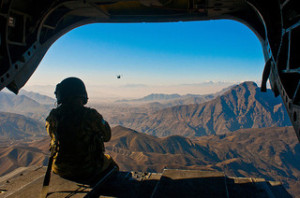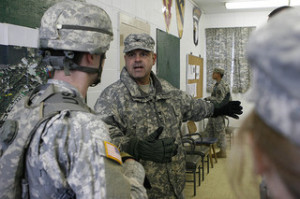 I had the privilege of escorting my wife on a trip over the last few days to New York City. Now those of you that know me, I am sure cannot imagine why I would want to go to New York City. Well I’ll tell you, because my wife has always wanted to go there. So I return to work today to relax a little bit and think about the pure and utter chaos that is NYC. It caused me to remember a “Leadership In Chaos” workshop I attended while I was in the military. The man that spoke during the workshop was a Colonel and an Airborne Ranger, and today as I write this, he is a leadership consultant at the Military Academy at West Point.
I had the privilege of escorting my wife on a trip over the last few days to New York City. Now those of you that know me, I am sure cannot imagine why I would want to go to New York City. Well I’ll tell you, because my wife has always wanted to go there. So I return to work today to relax a little bit and think about the pure and utter chaos that is NYC. It caused me to remember a “Leadership In Chaos” workshop I attended while I was in the military. The man that spoke during the workshop was a Colonel and an Airborne Ranger, and today as I write this, he is a leadership consultant at the Military Academy at West Point.
Last Thursday morning at 0530AM I found myself in Times Square standing outside of the Good Morning America studio preparing to be part of the audience that you see outside their window if you have ever watched the morning show. As the majority of this was pretty slow, I found myself wandering and looking around in Times Square at 6-ish AM. What did I see? That’s right you guessed it – chaos.
So I got to thinking how a leader would be able to maintain discipline and focus with surroundings like this?  I thought our military leaders could offer some ideas. If there is anything that today’s military leaders are comfortable with it is in being…uncomfortable. In places like Afghanistan (and Iraq before it), spans of control are so broad, geographic distances are so immense, and challenges so diverse that leaders cannot possibly be everywhere or know everything that is happening. The fog of war is an almost constant companion to our military heroes. “VUCA – Volatility, Uncertainty, Complexity, and Ambiguity – is the new normal.”
I thought our military leaders could offer some ideas. If there is anything that today’s military leaders are comfortable with it is in being…uncomfortable. In places like Afghanistan (and Iraq before it), spans of control are so broad, geographic distances are so immense, and challenges so diverse that leaders cannot possibly be everywhere or know everything that is happening. The fog of war is an almost constant companion to our military heroes. “VUCA – Volatility, Uncertainty, Complexity, and Ambiguity – is the new normal.”
Much of what we thought about organizational management is grounded in the “Command & Control” world, a paradigm that just doesn’t fit in today’s VUCA scenario. Places like Afghanistan are causing us to think differently about some aspects of leadership. “Decision cycles are too compressed to fit within the top-down Military Decision Making Process (MDMP).” Things that were accepted norms like, “No more than 5-7 direct reports” are not necessarily true, and can’t be any longer. Even leadership teachings about things like planning, risk, or scope of responsibility are being re-thought in light of what we are learning downrange.
So, with leadership as we thought we knew it in evolution, how do leaders provide clarity of purpose and thought and drive appropriate actions? What follows are some of the responsibilities leaders, in any setting, should use to make sense of the chaos and to enable the success of their Team. These are the basic elements that give today’s leaders comfort, despite how uncomfortable the situation may be. They give a leader presence, even though they may not be physically present, and drive the behaviors, decisions, and actions of the team – aligned in task and purpose. Leading in Chaos – Six Essentials to Stay Focused & Enable Success
1. Values – What is important to us and why? Leaders must ensure that the organization’s values are clear and reinforced at every opportunity. “More than just a poster in the hallway, the values must truly motivate behavior and help define black versus white in a world full of gray.”
2. Vision – Where are we going? What is our shared view of the end state, purpose, and key tasks that will keep us on track? “Vision inspires people to want to do more, especially when times are tough, because they believe in the purpose and have bought into the organizational direction.”
 3. Strategy – How do all of our actions align to get us out of this chaos and into calmer waters? Strategy adds specificity to the vision and connects short-, intermediate-, and long-term goals and objectives. “Strategy looks not just at how to execute the mission but also how to improve the organization (people, systems, processes, etc.) for sustainable success.”
3. Strategy – How do all of our actions align to get us out of this chaos and into calmer waters? Strategy adds specificity to the vision and connects short-, intermediate-, and long-term goals and objectives. “Strategy looks not just at how to execute the mission but also how to improve the organization (people, systems, processes, etc.) for sustainable success.”
4. Intent – Intent conveys to teammates guidance and direction, without actually being there. It communicates the desires of the leader, such that people can answer – for themselves – what would my boss want me to do if he/she was here? “The leader’s intent is the pathway through which people exercise initiative and take action, without being told, because they know what is required and why. The how is up to them.”
5. Information – What are the big picture and the context in which we execute? Nothing enables execution and the exercise of judgment, consistent with the leader’s intent, like being informed. Leaders over-communicate to ensure that the vision sounds like a “drumbeat” in people’s heads, keeping them in step and marching toward victory. “No more stovepipe communication that filters out all but what subordinate leaders think people need to know. Experienced leaders ensure that everyone has the full story and can take advantage of opportunities, learn from the challenges of others, and make decisions that align with the big picture.”
6. Alignment – How do we ensure consistency with regard to our actions, priorities, and resources? Leaders spend much of their time – in meetings or just walking around (we call it battlefield circulation) — checking and adjusting the alignment of the organization, ensuring the connection of individual actions with the overall team goals. “The role of the leader as ‘Chief Alignment Officer’ is among the most significant of the leader’s many responsibilities.”
Be sure, the chaos that defines our military operations can be just as prevalent and equally challenging to business leaders. Change is constant, decisions are made much closer to the problem, organizations are flatter, and people should be empowered to measure and manage risks and take bold action like never before. “Twenty-first century leaders, like their counterparts in the military, either learn to similarly operate in this VUCA environment by putting their time and energy into the elements above, or risk becoming bureaucratic, over budget, locked in the past, and teetering on irrelevancy!” They do this by learning to be comfortable being uncomfortable, turning on the “beacon” for their “troops” as they navigate through the “fog.”
Quoted portions written originally by Colonel Tom Magness (US Army RET.)
Photo credit: R. Fernandez / Foter / (CC BY-NC-SA 2.0)
Photo credit: The U.S. Army / Foter / (CC BY 2.0)
Photo credit: West Point – The U.S. Military Academy / Foter / (CC BY 2.0)
Photo credit: Henrique Vicente / Foter / (CC BY 2.0)



Please note: I reserve the right to delete comments that are offensive or off-topic.